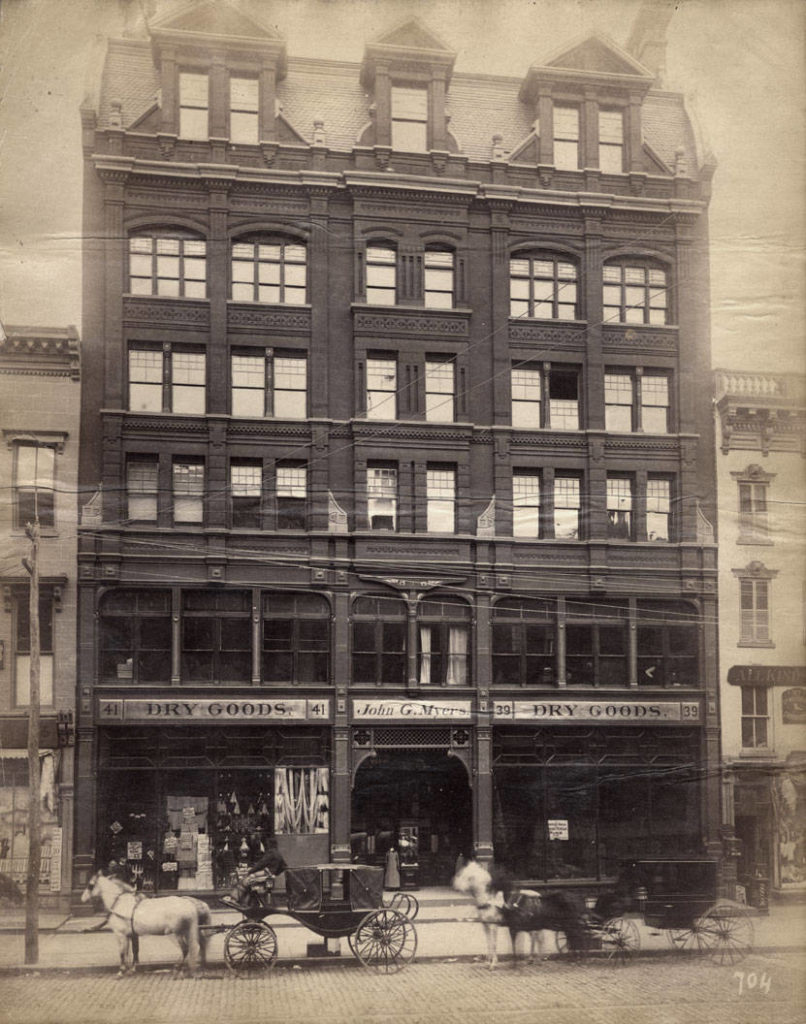
Hoxsie recently found that the Art Institute of Chicago’s Ryerson & Burnham Archives include a number of images of Albany architecture. It has a wonderful view we hadn’t seen before of John G. Myers’ dry goods store, 39-41 North Pearl Street. This photograph by Albert Levy is from somewhere between 1885 and 1895; the building was constructed in 1887 by the eminent Albany firm Ogden & Wright. The building would famously collapse in 1905 as the result of a clumsy construction undertaking. Reports of the deaths vary wildly, from 30 reported dead the day after, but reliable later reports say that 13 died.
In Cuyler Reynolds’ “The Albany Chronicles,” the collapse was reported:
[Aug. 8] The John G. Myers Dry Goods Co. store, Nos. 39-41 North Pearl street, collapses at the time the clerks are arriving to open the store, the roof of the immense 6-story building crashing through the cellar, bearing everything with it, entombing about 80 persons and killing 13 clerks, due to insecure underpinning and shoring in the cellar while extensive improvements were under way; the streets immediately guarded by a cordon of police and all ambulances of the city summoned, at noon the railroads sending up an army of men with picks to remove the debris, and the city officials rendering assistance under direction of Mayor Gaus in person on the scene.
Just a month later, the American Architect and Building News reported:
“The investigations into the collapse of the Myers department-store at Albany, a few weeks ago, conducted by the coroner and by a commission of experts appointed by the city’s mayor having resulted in practically identical reports, the contractor for the repairs, John Dyer, J., and his superintendent, Clark L. Daggett, have been arrested for manslaughter at the instance of the coroner and held to the grand jury under bail of five thousand dollars each. As the reports seem to be sensible, the men will probably be indicted and have to stand trial. The evidence is that excavation was carried too near the three piers that first collapsed and that about one of these piers no attempt at shoring had been made, while about the others the means and efforts used were palpably insufficient to provide the needed support for the loaded floors above. A blunder, in its results proved to be a crime, has been committed and punishment may properly be visited upon those responsible for it; but the real criminality in the matter is not reached and cannot be, since the public itself is the guilty party, because it has not by legal enactment forbidden the occupancy of buildings while undergoing repairs that may imperil their structural stability . . . It was a blunder to cause the collapse of the Albany building, but it was a crime, for which Mayor and coroner, in their degree, were alike responsible, that there should have been three hundred, more or less, employés and customers in the building with their lives at the risk of an always possible blunder.
The grand jury received the case on Sept. 25, but failed to issue indictments. It was sent to a second grand jury, which brought up Dyer and Daggett on charges of manslaughter. While that was going on, the Myers Company opened in temporary quarters at 69 North Pearl, where an engine fire burned the company out on Nov. 15, 1905. They then moved into the Boston Company’s dry goods store at the southeast corner of North Pearl and Steuben Streets, the site of which was once home to Gov. DeWitt Clinton. A foundation for a new permanent store on the site of the collapse was begun in February 1906, after which the store returned to prominence and survived until 1970.

1 thoughts on “The Myers Store Collapse”